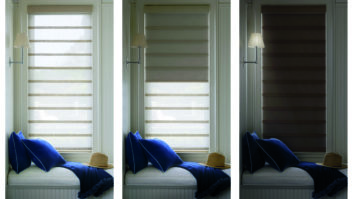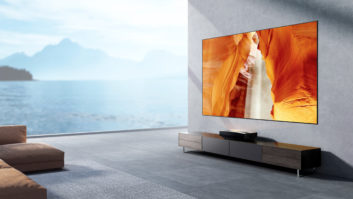New Technology From E3 Will Help Change Our Business Focus

During Microsoft’s E3 demo, the movements of
this gamer were accurately captured by the Project
Natal system and transferred to a kickball game.
Inset, the prototype game system
For the last few years we have all been hearing how the “next big thing” in the evolution of home cinema was going to involve some kind of new and advanced technology. Some have argued that we will be installing completely immersive visual worlds with 30 or more displays, all networked together for a near 360-degree virtual world experience. Others have told us that realistic and natural 3D technology, eliminating any need for those funny looking glasses, will be the next watershed development in the residential cinema experience
These and other promised breakthroughs have always remained “just around the corner” with unrefined technology or a gaping vacuum of desirable content undermining any wide spread adoption. And while there are certainly prototypes and oneof- a-kind installations, it’s very clear that these sorts of systems are rare and certainly do not represent new revenue opportunities for the average ESC. That, however, may all be about to change.
SELLING ENTERTAINMENT ENVIRONMENTS
Every year in June, the gaming industry gets together for its annual trade show, the Electronic Entertainment Expo, or E3 as it is known. This year at E3 Microsoft introduced a new set of entertainment technologies collectively called “Project Natal” that I believe could dramatically alter the way we sell, design, and install home cinemas. I predict that this new technology platform from Microsoft, and more importantly the new gaming experience that it will make possible, will finally open up amazing new opportunities to sell total “entertainment environments” that go way beyond the typical home cinema concept.

For the record, I am not a “gamer” in any way, shape, or form, and I can honestly say that part of the reason is that I have never really liked the experience of using those little hand-held controllers. It always seemed so limiting and awkward to me to be using only my hands and a bunch of buttons to try to enable my character on screen to do what I wanted. As it turns out, I am not all that different from many of our clients in this regard. Of course kids and many younger people enjoy gaming as a natural experience, but only since the introduction of the Nintendo Wii console, with its simple handheld wand controller, did a whole new group of “older” people like myself begin using and experiencing video games in a new and easily accessible way.
THE WII ONE BETTER
Microsoft has taken the more natural experience of the Wii console and strapped a rocket to it. There are three key technologies that make up Project Natal: facial recognition, voice recognition, and full-body gesture recognition. Each of these has been the focus of intensive research inside Microsoft for the last few years and the combined results are nothing short of amazing. The combination of all of these means that it will now be possible to build games that offer extremely natural and intuitive game play experiences that do not require any controller at all. There are many technically impressive achievements under the hood here, and I recommend you Google “Project Natal” and watch and read all you can (including our cover story on p. 24) for a much more in-depth understanding of the platform than I have room to cover here.
The most important element of all this is that with no game controller, millions of people who have never had the slightest desire to play “video games” will now be able to easily experience a whole new world of entertainment, naturally and easily. Why does this matter? Because included in those millions of people will be many of our clients, and the best way to experience this new world of gaming will be in a custom-built, totally immersive entertainment environment designed and installed by the local ESC.
DESIGNING SPACES

A new emphasis on gaming means one or more people will be standing or even moving around at the front of the “entertainment room.” Therefore, consideration will need to be given to the room layout and seating positions to allow considerably more space between the front row of seating and the screen.
More distance to the image means larger displays (flat panel or two-piece projection) and an absolute requirement for the best image possible. And, of course, larger rooms mean larger and more powerful sound systems, more seating, etc.
Lighting control also becomes more important as the desire to have a very dark area around the screen becomes just as essential as providing enough light to allow dad to “snowboard” down the hill with his daughter on screen, without falling over the coffee table.
The main take away here is that Project Natal will provide an entirely new gaming experience for our clients (not just their kids) that is exciting, – compelling, and best of all, effortless. This also means that we have a whole new story to tell beyond simply “home cinema.” We can and should become the experts that our clients and their design professionals turn to for guidance in designing these new “entertainment environments.”







